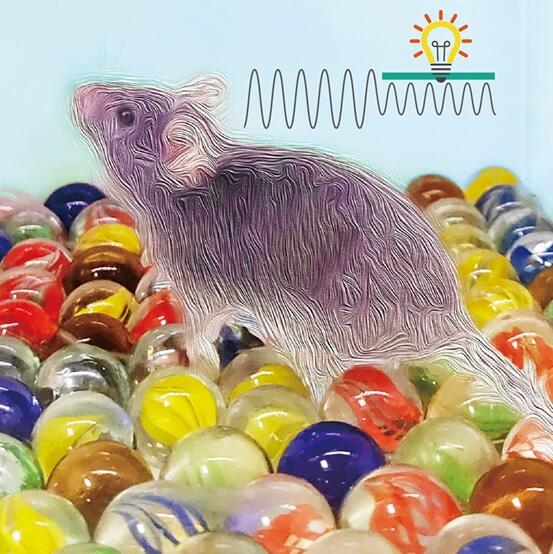Where does the feeling of anxiety without an identifiable cause come from? A group led by Graduate Student Wanqin Tan, Assistant Professor Yoko Ikoma, Graduate Student Yusuke Takahashi, and Professor Ko Matsui of the Graduate School of Life Sciences at Tohoku University, in collaboration with Gunma University and the University of Copenhagen, Denmark, has discovered that astrocytes (a type of cells in the brain) in the lateral habenula of the brain modulate the level of anxiety in mice. The results were published in Neuroscience Research.

Provided by Wanqin Tan, Ko Matsui
Humans and animals are constantly vigilant of their surroundings and subconsciously assess potential danger. The result of this can lead to a sense of anxiety that cannot be explained by the conscious mind.
Mice avoid open, brightly lit, and elevated areas. This is to avoid the risk of being targeted by predators. In an open environment without predators, mice appear to experience "anxiety" rather than "fear." A glass ball (marble) burying test is used to assess anxiety-like behavior in mice. To escape the anxiety caused by the marbles, the mice bury them in bedding to keep them out of vision. Since the number of marbles hidden decreases when anxiolytics are administered, the level of anxiety can be assessed by how many marbles are hidden in a given time.
To test this, an all-marble cage with the entire floor covered in marbles was prepared as an anxiety-inducing environment. The mice experienced significant anxiety of not being able to escape because the marbles could not be covered by bedding. When mice were placed in this cage, recording of neural activity in the habenula as local field potentials revealed enhanced activity in the theta band. By reversing the order of the events in the above experiment, it was assumed that electrical stimulation of the habenula with a theta band can induce anxiety-like behavior.
A two-way bright-dark apparatus was designed to verify this assumption. The apparatus consisted of a bright room with an all-marble cage and a dark room with comfortable bedding. When mice were placed in the bright room to begin the test, they often moved to and remained in the comfortable dark room. When electrical stimulation of the theta band at 8 Hz was applied to the habenula each time mice entered the dark room from the bright room, the mice were more likely to stay in the bright room. Moreover, the total time the mice spent in the bright room was significantly longer than that of the control group. This suggests that electrical stimulation of the habenula in the theta band led to aversion to the dark room and artificially induced anxiety-like behavior.
To measure local changes in the brain environment associated with anxiety, mice expressing astrocyte-specific fluorescent calcium ion sensors, fluorescent pH sensors, and albumin mScarlet in the blood were used.
An optical fiber was implanted in the habenula of these mice, excitation light was transmitted, and the returned fluorescence was measured (fiber photometry method). Albumin mScarlet fluorescence in the blood showed increased local cerebral blood flow in the habenula when the mice were placed in the anxiety-inducing environment. Visualization of changes in intra-astrocyte calcium ions and pH in the fluorescent sensor-expressing mice revealed decreased levels of calcium ions in habenular astrocytes and an acidified pH in the anxiety-inducing environment.
The acidification response of astrocytes may operate through a pathway in which glutamate and other transmitters are released from astrocytes. This glutamate then acts on neurons to increase theta-band activity. If this is the mechanism, the artificial alkalinization of the intracellular contents of astrocytes could produce anxiolytic effects. Therefore, mice expressing the astrocyte-specific gene ArchT (a light-sensitive hydrogen ion outward pump) were generated. When exposed to light, alkalization occurs within cells of astrocytes.
When mice are placed in an all-marble cage, local field potentials in the theta band increase. Light activation of ArchT in astrocytes of the bilateral habenula attenuated neural activity in the theta band. In the two-way bright-dark apparatus, the mice were more likely to stay in the dark room. In contrast, light stimulation of ArchT in the astrocytes in the habenula of mice in the experimental group caused the mice to move from the dark to the bright room. They also tended to explore longer distances in the bright room than mice in the control group.
These findings are expected to lead to new treatment strategies for anxiety disorders, including drugs that affect the function of astrocytes in the habenula.
Journal Information
Publication: Neuroscience Research
Title: Anxiety control by astrocytes in the lateral habenula
DOI: 10.1016/j.neures.2024.01.006
This article has been translated by JST with permission from The Science News Ltd. (https://sci-news.co.jp/). Unauthorized reproduction of the article and photographs is prohibited.




